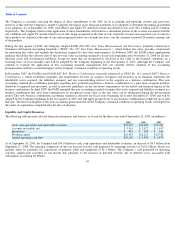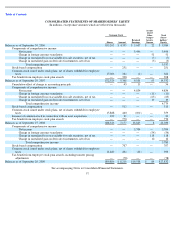Apple 2009 Annual Report Download - page 51
Download and view the complete annual report
Please find page 51 of the 2009 Apple annual report below. You can navigate through the pages in the report by either clicking on the pages listed below, or by using the keyword search tool below to find specific information within the annual report.
Table of Contents
as of September 26, 2009 and the net unrealized losses as of September 27, 2008 related primarily to long-
term marketable securities. The
Company considers the declines in market value of its marketable securities investment portfolio to be temporary in nature. The unrealized
losses on the Company’
s marketable securities were caused primarily by changes in market interest rates, specifically widening credit spreads.
The Company does not have the intent to sell, nor is it more likely than not the Company will be required to sell, any investment before recovery
of its amortized cost basis. Accordingly, no material declines in fair value were recognized in the Company’
s Consolidated Statements of
Operations during 2009, 2008 and 2007. The Company may sell certain of its marketable securities prior to their stated maturities for strategic
purposes, in anticipation of credit deterioration, or for duration management. The Company recognized no material net gains or losses during
2009, 2008 and 2007 related to such sales.
Provision for Income Taxes
The Company’s effective tax rates were 29%, 30% and 30% for 2009, 2008 and 2007, respectively. The Company’
s effective rates for these
periods differ from the statutory federal income tax rate of 35% due primarily to certain undistributed foreign earnings for which no U.S. taxes
are provided because such earnings are intended to be indefinitely reinvested outside the U.S.
As of September 26, 2009, the Company had deferred tax assets arising from deductible temporary differences, tax losses, and tax credits of $3.2
billion before being offset against certain deferred liabilities of $1.8 billion for presentation on the Company’
s Consolidated Balance Sheet.
Management believes it is more likely than not that forecasted income, including income that may be generated as a result of certain tax planning
strategies, together with the tax effects of the deferred tax liabilities, will be sufficient to fully recover the remaining deferred tax assets. The
Company will continue to evaluate the realizability of deferred tax assets quarterly by assessing the need for and amount of the valuation
allowance.
The Internal Revenue Service (the “IRS”) has completed its field audit of the Company’
s federal income tax returns for the years 2002 through
2003 and proposed certain adjustments. The Company has contested certain of these adjustments through the IRS Appeals Office. All IRS audit
issues for years prior to 2002 have been resolved. In addition, the Company is subject to audits by state, local, and foreign tax
authorities. Management believes that adequate provision has been made for any adjustments that may result from tax examinations. However,
the outcome of tax audits cannot be predicted with certainty. If any issues addressed in the Company’
s tax audits are resolved in a manner not
consistent with management’
s expectations, the Company could be required to adjust its provision for income taxes in the period such resolution
occurs.
Recent Accounting Pronouncements
In September 2009, the Financial Accounting Standards Boards (“FASB”) amended the Accounting Standards Codification (“ASC”)
as
summarized in Accounting Standards Update (“ASU”) 2009-14,
Software (Topic 985): Certain Revenue Arrangements That Include Software
Elements
, and ASU 2009-13, Revenue Recognition (Topic 605): Multiple-Deliverable Revenue Arrangements . As summarized in ASU 2009-
14, ASC Topic 985 has been amended to remove from the scope of industry specific revenue accounting guidance for software and software
related transactions, tangible products containing software components and non-
software components that function together to deliver the
product’s essential functionality. As summarized in ASU 2009-
13, ASC Topic 605 has been amended (1) to provide updated guidance on
whether multiple deliverables exist, how the deliverables in an arrangement should be separated, and the consideration allocated; (2) to require
an entity to allocate revenue in an arrangement using estimated selling prices of deliverables if a vendor does not have vendor-
specific objective
evidence (“VSOE”) or third-
party evidence of selling price; and (3) to eliminate the use of the residual method and require an entity to allocate
revenue using the relative selling price method. The accounting changes summarized in ASU 2009-14 and ASU 2009-
13 are both effective for
fiscal years beginning on or after June 15, 2010, with early adoption permitted. Adoption may either be on a prospective basis or by retrospective
application.
48
























